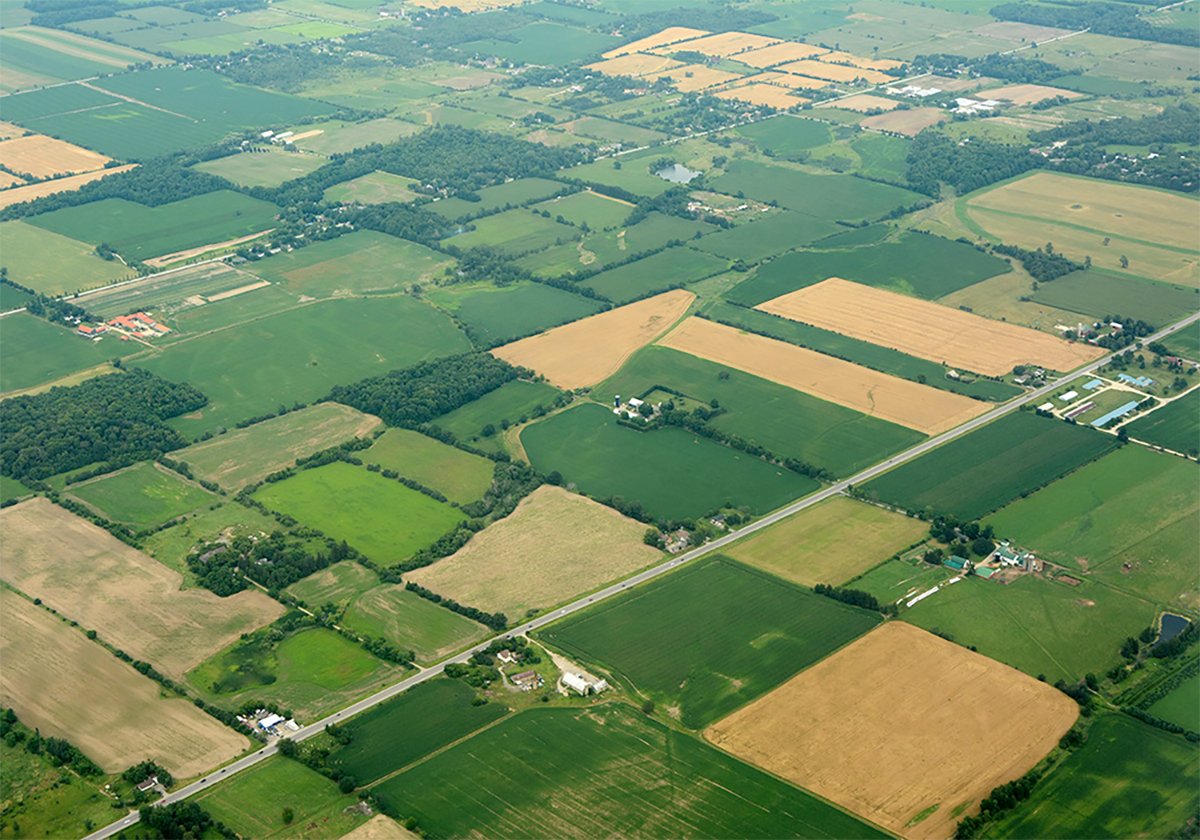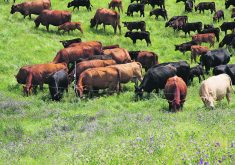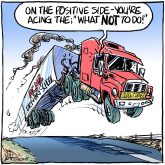Canola legume
I’m probably not the first person to have this idea but my billion dollar idea is legume canola plus wheat etc. Would some company like Monsanto please develop legume canola plus wheat, etc.?
Think of the terminal use agreement fees you could charge. A fair price would be 50 percent of the actual cost of nitrogen fertilizer. Farmers could save 50 percent of the cost of nitrogen plus the transportation and application costs.
The feds might have a better chance reducing greenhouse gas emissions. This would be a win-win-win situation.
Read Also

Higher farmland taxes for investors could solve two problems
The highest education and health care land tax would be for landlords, including investment companies, with no family ties to the land.
This must be able to be done because there has been genetically modified crops around for years. If there is a company trying to develop legume canola plus wheat, etc., please let me know so I can buy shares in your company.
– Gary Garman,
Allan, Sask.
Asked for choice
Canadian Wheat Board director Art Macklin’s letter of Nov. 22 about how (Stephen) Harper wants to destroy the CWB is incorrect.
Mr. Macklin doesn’t seem to understand that 62 percent of western Canadian farmers recently voted to have the freedom to market their barley to the buyer of their choice.
Mr. Macklin needs to understand that the government of Canada only wants to give the farmers inWestern Canada the same freedom that farmers in eastern Canada already have.
Mr. Macklin makes reference to Stephen Harper supporting supply management in Quebec and Ontario. Mr. Harper should and does support these farmers because that’s what they want. Farmers in Western Canada want marketing choice. Mr. Harper wants to give farmers in Western Canada what they have asked for, the freedom to market their barley to the buyer of their choice.
Unfortunately, Mr. Macklin does not respect the rights of western Canadian farmers. Mr. Macklin states that the CWB acting as a single desk is able to negotiate a better price for farmers.
On Nov. 21 the spring wheat price per bushel in Saskatchewan using $1.50 deduction was $6.64. The Ontario price for spring wheat was $8.79, the price in Montana for spring wheat was $8.85. Where is the premium Mr. Macklin refers to?
The farmgate price for two-row malt barley in Montana on Nov. 21 was $6.60 per bushel. The Saskatchewan farm price for malt barley is expected to be less than $5 per bu. if marketed through the CWB. Where is the premium Mr. Macklin refers to?
Mr. Macklin should listen to what farmers in Western Canada have asked for and that is to be able to market their barley to the buyer of their choice.
– David Schnell,
Kenosee Lake, Sask.
Flawed system
Re: “Archaic CWB” (Open Forum, Nov. 22).
The CWB is a very small problem to farmers. Open market is our biggest culprit in farming….
Jeff Nielsen (Open Forum, Nov. 22) omitted the disaster of cattle prices caused by high feed prices. If the CWB is gone, we will have the same two choices as cattle farmers have: take the price offered or take the produce back home.
I don’t know what is the hangup. The farmers can choose to sell all their grain into the open market without involving the CWB at lower price.
Why must grain farms have to subsidize the cattle operation? Why can’t us farmers work together instead of being divided? Any farm policies have to be designed in Western Canada to treat all farmers equally and not for a select few or for corporations’ gains.
Older farmers are very cautious about changes that commodity farm groups are proposing. These farmers have been used and financially abused by the open marketing system….
– Eric Sagan,
Melville, Sask.
Local gov’t
It is a rare case in the Rural Municipality of Moose Creek that more than one candidate files a nomination paper in the election process for a councillor or reeve.
However, by the nomination deadline last month for the position of Division 5 councillor, two candidates had submitted their papers. What is a surprise is that the council position for Division 5 remains vacant until next February and probably sometime thereafter.
As expected, all three other incumbents were unopposed.
Perhaps if the eligible voters would actually take an interest in choosing someone to represent themselves at the local level of government we would have a full complement of representatives. We might hope that everyone would always receive a fair hearing on any matter before council.Â
It might even become normal for council to want to become accountable and be very willing to consult and thereafter inform all their constituents of the decisions reached during council meetings.
Once this major attitude change is achieved, it will not be acceptable to advance wholly personal agendas, interfere with a foreman’s duties, act outside the jurisdiction of the municipalities act or for council members to bill for remuneration that … is approximately double that of any comparable adjacent RM.
I am convinced that voters will continue to get the local government that they deserve. Absolutely nothing will change until the eligible voters refuse to tolerate what they have been receiving and instead take an active interest in choosing whom they wish to represent them for the next term, or as we now see in the case of Division 5, for the portion thereof.
– Murray C. Johnson,
Oxbow, Sask.
CWB ‘help’
With wheat prices soaring to a 10-year high, CWB chair Ken Ritter is claiming that “prairie farmers can expect significantly higher returns this year than their American counterparts, due to the disciplined selling of the CWB.”
While it does appear that many Americans sold their wheat early and missed the recent price surge, the implication that therefore prairie farmers are better off under the CWB’s monopoly is misleading for a number of reasons.
1. While some prairie farmers might do better because of their mandatory participation in the CWB’s marketing system, some farmers will not. Unlike last year’s barley marketing strategy at the CWB, not everyone sells early and sells low and therefore not everyone appreciates the CWB’s paternalistic pat on the head.
2. The CWB’s monopoly removes producers’ ability to manage their own business. While price is an important factor in making a sale, timing is equally so.
The CWB monopoly removes the prairie producer’s ability to control either, restricting their ability to properly manage their farm’s cash flow.
3. Ken Ritter appears to be confusing the CWB’s pooling function with its monopoly status. It is the CWB’s pooling system, not its monopoly status, which means the producer’s delivery date will not affect the price he receives for his grain. Someone should send a memo to Mr. Ritter: pooling systems can be voluntary. …
Those who prefer to manage their risk through a pooling system should be allowed to do so. Likewise, those who prefer to use other tools should be free to do so. Not everyone wants the CWB’s “help.”
– David Anderson, MP,
Parliamentary Secretary to the Minister of Agriculture,
Swift Current, Sask.
Price source
In his letter of Nov. 22, David Schnell questions where I got information regarding the average returns being received by durum producers in the United States. I am pleased to provide the quotes and attribution for your readers.
As early as Sept. 27, Jim Peterson, the marketing director for the North Dakota Wheat Commission, told the Farm & Ranch Guide that most North Dakota durum producers sold early and were unable to capitalize on high prices.
“We’ve talked to producers who have gotten $10 a bushel, but the producers are rare who are holding on to durum to sell at these higher prices because so many took advantage of the good prices at $7 per bu. …In hindsight, producers are probably wishing they hadn’t sold so much so soon.”
On Oct. 26, Peterson told The Prairie Star that spot prices were climbing above $18 per bu. for durum because there was almost no one left to fill the demand.
“Peterson said current price levels are deceiving, because there’s a lot less volume trading at these levels than there was before.”
Forward contracting is the norm in the U.S., and the situation is not contained to North Dakota, nor to durum. Tom Mick, president of the Washington Wheat Commission, told Associated Press on Oct. 2 that wheat farmers in that state were 70 percent sold at less than $5 per bu. …
While spot prices may look better than the pooled price, the reality is very few farmers capture these high returns. The average durum producer in Western Canada can expect to receive more for their durum this crop year than the average durum producer in the United States.
– Ken Ritter,
Chair, CWB Board of Directors,
Kindersley, Sask.
Too much primp
I had to laugh as I walked through the barns at (Canadian Western) Agribition last week and was hit with the stench of hairspray, glue and aerosol paints overpowering more normal barn smells.
The breeders are spouting rhetoric about the best genetics, all the while spending their time painting, preening, and trying to hide their cattle’s flaws. The cattle on display were about as separated from the ranch animals they are supposed to improve as a metrosexual lawyer is from a prairie cowboy. Let’s see a competition that’ll truly prove the cattle’s worth.
First, all animals shown should be raised on forage with less than $20 per animal annually going to supplemental feed. Let’s see their natural fleshing ability.
Second, all cows shown must have raised one calf every year. All bulls must have naturally sired at least 40 calves per year. The best looking animal is worth nothing if he/she can’t reproduce.
Third, the cattle should be shown clean and dry but without any trimming, painting or spraying. Only the cattle’s genetics should be on display.
Until such a real competition exists, I’ll continue to view cattle shows with the distance and skepticism they deserve. At worst, they are killing our commercial industry by promoting fancy cows with too high of maintenance requirements to be affordable with today’s calf prices.
At best, they are a separate entertainment industry with about as much value as their human beauty contest counterparts.
The era of cheap oil and cheap grain is coming to an end. For commercial herds to be successful in the next era, we need to evaluate our animals in terms of efficiency, not just production.
– Margaret Leigh,
Melfort, Sask.
Metric division
In John Hamon’s letter of Nov. 10, he makes mention that land would have to be redivided when the metric system came into effect some 30 years ago, and that it is a problem that has not been solved yet.
I say redivided because, as I understand it, Mr. Hamon’s part of Saskatchewan was surveyed and divided up before 1900.
Mr. Hamon implies that land measurements using the Imperial system are easily and evenly divisible by the magic number of 12 rather than 10.
Let’s have a look at that. Pretty well all of Saskatchewan and Alberta were surveyed using the third Dominion Survey, which required each township to measure 486 chains along its baseline and 483 chains along its east boundary. Neither of those numbers are divisible by 10 or 12.
Today these township measurements are 9,720 metres and 9,660 metres respectively, both evenly divisible by 10 but not 12.
Most farmers did not use chains to measure land but instead used rods, yards or feet. A quarter section, on each side, measured 160 rods, 880 yards or 2,640 feet, all divisible by 10 but not 12.
Today the same quarter sections measure 800 metres on each side, which is divisible by 10 and not 12. An acre is 10 square chains, 160 square rods, 4,840 square yards, or 43,560 square feet, all divisible by 10 but not 12.
The only time that 12 figures in the old system is the fact that the foot can be divided by 12 to get inches. So much for the magic number of 12.
Using either system, nothing is absolute and exact. The words “about” and “more or less” are used throughout.
For instance, sections were to be “about” 80 chains on each side. On land titles, quarter sections are described as xx hectares (xxx acres) “more or less.” Some have 160 acres while others have 159 or 161 acres, all “more or less.”
The quarter sections that were surveyed using chains as the unit of measure are still there. Surveyors today measure these same quarters, when necessary, using metres as the unit of measure, and nobody has lost or gained any land.
In order for someone to know that a problem exists with the land survey and the change to the metric system, that someone would have to be able to understand both the Imperial and metric systems thoroughly.
I suspect that after 30 years, Mr. Hamon knows all there is to know about both systems and I suggest that he grab a pencil and paper and share with us, in detail, how the problem really exists.
By then he would also have the solution, more or less.
Oh, by the way, 160 acres is divisible by 10, but not 12.
– Don Budesheim,
Grande Prairie, Alta.
Dual barley
I am writing this letter to inform our provincial government and our federal government and also the Western Barley (Growers) Association that we have a dual marketing system for barley in Western Canada.
In Alberta and I believe also in Saskatchewan, 90 percent of the barley goes for feed barley and does not go through the Canadian Wheat Board.
My sons and I have sold all our barley to elevator companies or to feedlot operators and also delivered it to them, avoiding the high cost of freight. There is only a small amount of barley going to CWB, which is mainly malt barley and export barley.
A number of years ago, when feed barley was selling very low, the CWB received a fair share of it. This proves the wheat board sets a floor price for barley when there is a surplus.
I ask, what more do our governments want of the CWB? Feed barley prices for feedlots are set by corn prices in the U.S.
I feel our governments feel if they can have the CWB lose its monopoly on barley, then they will work on eliminating the CWB handling our wheat.
Many people don’t understand the U.S. government is subsidizing the grain companies in the U.S. so they can pay a higher price to farmers and sell it cheaper on the foreign markets.
I don’t think Canadian farmers will be allowed to sell grain to American companies in the U.S. if the U.S. government is subsidizing U.S. grain companies.
How come oil companies can work together and set fuel prices without any interference from our governments? We have the fuel in Canada and pay more for it than our southern neighbours that import it from Canada. Is this right?
– Frank Gechter,
Medicine Hat, Alta.
Demand illegal
As farmers, we know it’s a fact that having lots of demand for our grain is a good thing.
Ideally, we’d like to have many buyers from Canada and from all over the world literally lusting after our grain. That is a good thing. Drives prices up.
How the Wheat Board Act works, and how it is supposed to work, is it simply makes all the demand illegal. All those buyers are abolished. The CWB monopoly is, simply put, the absence of demand for your grain, thus giving you no other choice but to hand it over to them as they order it.
The events leading up to July 31 this year for barley were a real illustration of that for me. Numerous bidders were driving up the price of grain. Countless deals were made between these companies, brokers, maltsters and farmers.
On Aug. 1 we returned to the old system and all these deals became illegal. Poof. All these buyers were gone. Naturally our barley prices returned to their discount in relation to world values.
Some still think that having a sort of gigantic picket line between us and this huge world full of countless opportunities is a superior way to do business. They will go on supporting the CWB, but I believe that increasingly, westerners understand that open markets, combined with voluntary collaborative action, is a superior model as illustrated by the success of all other crops. …
Those who prefer the command system to a demand system will continue to support the status quo.
– Jim Pallister,
Portage la Prairie, Man.
100-mile diet
I first heard of the 100-mile diet in the Globe and Mail last spring.
The concept intrigued me. The idea of eating foods produced within a certain area in order to conserve energy really made me think. I checked out the 100-mile diet website and signed up for regular updates, but even as I moved on to another site, I began to wonder about the implications of taking on this program. Where would I get my favourite foods and how would I cope without some of them?
Although I think the effort commendable, I have decided it’s just not for me. To justify my decision, I produced the following poem. Though a bit tongue-in-cheek, it clarifies my position.
Claudette Sandecki, a friend of mine who writes an opinion column for The Terrace Standard in B.C., suggested The Western Producer’s editor might be open to publishing such a piece. I’m happy that she was correct.
 Â
Miles To Go Before I Eat
I’m thinking about the new 100-Mile Diet
It can’t be that hard. Can it? Nah! Sure, I’ll try it.
Let’s see, if I look at the distance they say,
I can buy from as far as the grand GTA!
That isn’t so bad. Now, where else can I go?
All the way down to Erie, and, wow! Buffalo.
I hope in Kincardine there’s fresh cheese to fill ya.
Does “Joe”, fairly traded grow up in Orillia?
Avocadoes must rise in my radius somewhere;
I mean, no guacamole just wouldn’t be fair!
Please tell me the rice called basmati springs forth
In a field in Niagara or somewhere up North.
Will I have to press pasta and freeze fruit and veg?
I’m sure living sans chocolate will put me on edge.
And what of my felines? Their grub’s from the States.
They’re fussy enough about what’s on their plates.
I could possibly do without catch from the coast,
But I know I’ll just die without P-B on toast!
I’d like to help out the environment cause,
Erasing my footprint of carbon, (Applause!)
But-
If I’m forced to relinquish my cherished cuisine
I’ll have to eschew – it’s so tough going green!
– Kathleen Mortensen,
Kitchener, Ont.














